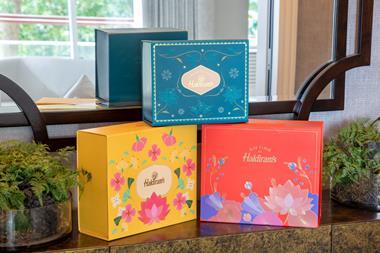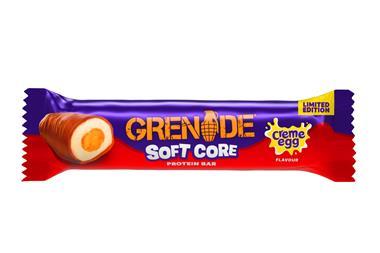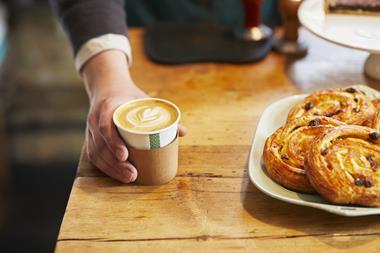Shoppers of all ages can’t resist the lure of sugar confectionery. Keep them sweet with a mix of sharing bags, kids’ lines and value items.
Gluten-free crisps. Post-workout protein bars. Fruit snacks. Healthy products such as these may be all well and good to have on the shelves, but some c-store customers still want to come in and indulge their sweet spot.
After all, at the office people might tell their friends that they always go for healthier options, but when it’s between them and the counter they often find that sweetness is their weakness.
This ‘guilty pleasure’ principle helps make confectionery big business here in the UK. Research shows that the confectionery market is worth more than £5.5bn, with the candy sector making up a substantial £1.3bn of sales (Nielsen). Plus, its impulse nature (“I’ll just grab some sweets on the way home”) makes it a natural c-store match, with convenience accounting for nearly a quarter (24%) of total confectionery sales (Nielsen).
If you’re wondering when’s the best time of year to double-down on sugar confectionery, Sam Coldbeck from Wharfedale Premier Stores in Hull has a simple answer: right now.
“It’s just something that we sell more heavily in the summer,” she says. “We stock sugar confectionery right the way through the year, but promote it more during spring and summer. It’s always ‘winter chocolate/summer sweets’.
“I think that’s because, as it warms up, you get a variety of people going out in cars, and kids coming in off the street looking for something sweet. They don’t necessarily want chocolate when it’s hot, so sugar confectionery sells nicely for us.”
Over in Southampton, Richard Inglis, who owns three Welcome Co-op franchise stores, confirms that sugar confectionery is a key part of his core offer.
“I think that any food store that sells confectionery and says it’s not important to them isn’t really looking at their numbers,” he says.
“Confectionery is a big part of what we do. It’s also – even though the margins have possibly suffered a little bit in recent years – a very strong profit driver. I’d say with sugar confectionery most people are making more than 35% as a general rule. It’s a really profitable section, especially since you can pack quite a lot into a relatively small area of the store.”
Despite the attractive profit factor, Richard regularly looks at his range to weed out the worst performers. He says that they’re often replaced with pricemarked packs – which do really well with his customers.
This is because getting a value-for-money deal in front of customers is an important way to drive purchases, with the pound price point particularly appealing in this competitive category.
Outside of PMPs (and Haribo – which he says is always a strong seller among both kids and adults), Richard singles out the Big Night In occasion as a substantial trend in sugar confectionery.
That isn’t surprising. According to research from HIM, snacks are the most popular category for c-store customers shopping the occasion. And with 30% of shoppers regularly meeting for at-home movie nights, it’s definitely a trend with legs.
“In some ways I’d liken it to what’s happening in the crisps market,” he says.
“A few years ago everyone was buying the small bags of crisps, but now the bigger bags are definitely the way to go for us.
“It’s another sharing thing. It might be a couple staying at home, or teenagers getting together to watch a movie or play console games. They want some sweets there in front of them.”
While sharing might be caring, there’s one sweetie selection that’s probably most enjoyable done on your own – choosing a tub of pick and mix. Richard has just got back into offering Pick and Mix and says it’s an area enjoying growth in-store. Despite trying American confectionery (and enjoying some success), he finds that the traditional British favourites are still the big winners.
“We do a sort of retro selection from Bonds,” he says. “Customers can pick up a small cupful for £1.99, or get a medium cup for £2.49.
“We’re not particularly family driven where we are, but little kids always drag their families to the pick and mix, and students and young professionals are buying it.
“I think there’s a definite ‘treat’ motivation going on. People think ‘Well, I’ve been really healthy all week so now I’m going to take home some pick and mix as a treat’. The adult customers like the retro twist – and it keeps the category interesting.
“If you’ve got something no one else has then that’s great.”
Summer selection
Haribo is celebrating summer with limited-edition flavours for Starmix and Tangfastics. They include ice cream and sorbet, a cherry-flavoured purple heart and a pomegranate and cranberry bottle.
Sour power
To drive growth in grown-up candy Maynards Bassetts has launched new Wine Gums Tangy – a sour take on the classic adult sweets.
Core candy
Swizzels has expanded its range with Refreshers Sour Apple chew bars featuring an extra hit of sherbet. Eye-catching green packaging with a 10p flash ensures shelf appeal at a pocket-money price.
Beach bonanza
Mentos Mix on the Beach offers three fruity chewy flavour combinations – perfect for popping in the beach bag for sunny days, or slipping from the glove box when it’s pouring down with rain.
Roxx and roll
Consumers love quirky sweets and with Maoam’s Crazy Roxx chews no two packs are exactly the same. How’s that for a point of difference?
Rowntree’s reduces sugar
This July Rowntree’s is making an assault on the reduced-sugar category with 30% Less Sugar Fruit Pastilles and 30% Less Sugar Randoms. Perfect if your customers want a healthier choice.
Richard explains that seven or eight years ago “everybody” was doing pick and mix and admits that one of the reasons they stopped may have been the effort required to keep the fixture nice and clean. He says that a big challenge is maintaining freshness, because products naturally start to harden as soon as the pack is opened. This can lead to hard chews at the bottom of bins and a certain level of wastage.
To keep pick and mix looking and tasting sweet, his strategy is to part-fill bins, to keep the confectionery at peak freshness. Then once it’s empty, the bins will be thoroughly cleaned before the next lot goes in.
“We won’t fill bins to the top like you see at the cinema; we’ll maybe only half fill them,” he says.
“It can sometimes mean it doesn’t look as full as it could do, but then I want to give my customers a good-quality product. There’s nothing worse than having something that looks fantastic, but when you eat it it tastes terrible, or is hard and chewy.”
Back in Hull, Sam isn’t a fan of pick and mix. She says this is mainly because, unlike Richard’s student customers, her regulars are younger kids who could sometimes accidentally make a mess of the section.
“What we found with pick and mix was that things dry out and it felt particularly unhygienic,” she says. “You’ve got a lot of waste when kids start filling a cupful of sweets and then drop it all over the floor, or kick the sweets under the stand. That wasn’t great.”
Instead, Sam says she now does “marvellously well” with penny sweets. She has a member of staff who spends an hour-and-a-half each week packing products into pound bags. “It’s done in the back room, with gloves on, very hygienically,” she says.
“They’re basically sealed and packaged and ready to go so customers are getting a pound bag with the penny sweets at full value.
“The kids get their penny shrimps and everything else, but we haven’t got any children sneezing all over our stock! They go straight on the counter with a pound sticker. We probably sell about 140 a week and make 50% on them.”
“The parents buy them for their kids and then nick a few when they get home.”
This hands-off approach also works for Bob Bettesworth, from Bob’s Shop in Newdigate, Surrey. “Confectionery does really well for us and it’s probably the third most popular product in the store overall,” he says.
“People like the pound bags because they seem to be at the right price for kids and their parents. We do well with the pick and mix, too, but we also make sure the kids put the lids back on the jars and help keep it looking tidy.”
Bags of choice
When it comes to getting one over on the mults, c-store retailers have got growth opportunities in the bag.
“Bags are by far the biggest growth opportunity for retailers, and are currently growing at +5.6% in convenience stores (IRI),” says Mark Roberts, trade marketing manager at Perfetti Van Melle. “Although supermarkets have the bigger share of the market (48% vs. 39%, IRI) sales are declining [there], opening the window of opportunity for convenience retailers.”
As Roberts explains, bags are a “congested market” (although Fruittella is providing excellent cut-through and growing 19% year on year in the sector). This means picking the best-selling lines to ensure maximum returns.
Meanwhile, although it’s parents that tend to buy the bags to share with the family, getting kids involved is a must.
“Kids are involved in 70% of purchase decisions so it’s more important than ever to ensure that dedicated kids’ zones are accessible, colourful and fun,” says Roberts.
“A large driver for purchases are for treats or reward, so drive basket spend by creating multi-buy deals on pocket-money lines such as our Chupa Chups lollipops or Airheads.
“Also, shelves should be low down so children can reach the items easily and pick and choose.”
As shop managers can testify, it isn’t just the pick and mix selection that can get a bit messy. Retailers and brands alike agree that it makes sense to merchandise pocket-sized confectionery items near the till to disrupt the shopper’s journey and create extra impulse buys.
However, in such a high-traffic area it can be tough to keep them looking neat so customers can easily see exactly what’s on offer. “Because most sugar confectionery products are packaged in bags of varying sizes, getting a fixture to look neat can be problematic,” says Duncan Hill, managing director at HL POS Centre.
“Traditionally, bags have been merchandised on hooks, but when consumers are pressed for time these can be inconvenient. Product is sometimes difficult to remove and if a shopper changes their mind they either have to grapple with the bag to get it back on the hook, or will leave it at the bottom of the fixture or a nearby shelf. This clearly isn’t ideal.”
To meet their needs, HL offers a NEXT pusher tray system that creates dedicated product lanes – potentially increasing the number of facings by 20%. Pusher feeds ensure the sweets never run out by keeping product feeding through to the front of the fixture, while each packet is held securely in place to stop spills.
As well as making the sweets section look good, retailers agree that making sure you’ve got a clear point of difference pays dividends. For Peter Lamb, from Lambs Larder in East Sussex, having exciting and relatively exclusive new lines, alongside existing customer favourites, helps set his offer apart.
“Customers come into the shop and see our range of American confectionery, for instance, and understand that it’s not the kind of thing they can just pick up on the weekend in Morrisons,” he says.
‘This is important because confectionery is one of the things we really focus on in store, because it’s such an impulse buy.”
One of the store’s big sellers is Hubba Bubba Tape, an American line which Peter says comes in flavours you can’t normally get in the UK. He’s also had lots of success from Blockhead Energy Gum, an innovative product that’s manufactured locally.
“It’s like the Red Bull of the chewing gum world,” he says.
“It definitely works. They do a vitamin gum, too, and it’s something I use myself. It’s got a big following because the long-distance lorry drivers come in and they’re always looking for something to give them a bit of a boost.
“I’ve got customers that come in for it every week just because it works for them.”
Cutting sugar content
With its bright colours and natural kiddie appeal, the world of sugar confectionery is a fun place to be. Yet, there’s one particular shadow haunting the usually happy land of sweets: the sugar tax.
This year the chancellor confirmed that soft drink importers or producers will have to pay a sugar tax of 18p per litre on drinks containing 5g or more of sugar per 100ml. And now health campaigners Action on Sugar are demanding the tax should cover sweets, too.
The pressure group claims that chocolate and sugar confectionery accounts for 9% of all the sugar eaten by children aged between four and 10 in the UK.
To prove they’re taking action (before it’s forced upon them by new laws), manufacturers have already made successful moves to expand the sugar-free offer in-store. For example, Fruittella has launched a sugar-free gums and foams product and has a 30% reduced-sugar variant.
Keep the magic alive with innovative lines
From Willy Wonka’s crazy creations to the Every Flavour Jelly Beans Harry Potter and his mates munched on, confectionery has always been about conjuring a bit of magic. According to Jonathan Summerley, Hancocks purchasing director, manufacturers need every bit of sparkle to overcome the twin challenges of the sugar tax and Brexit.
“The environment in which confectioners operate is changing and having knock-on effects on customer needs – which now take the shape of unique flavours and low-sugar products,” he says.
“This means that it’s essential for suppliers to invest in research and development, to drive the creation of innovative products that meet changing customer needs to strike the perfect balance between taste and healthier confectionery.”
For Hancock’s this means coming up with kid-pleasing products such as the fearsome-sounding Brain Licker and retro-cool Cola Bottles alongside classic choices made healthier, such as sugar-free Werther’s Original.
Presentation in store is also important and Summerley advises retailers to harness the vivid colours commonly found in the category. “Sugar confectionery is usually colourful so c-stores should make the most of this by generating creative displays that give customers lots to look at and maximise the return from each transaction,” he says. “The use of freestanding display units can also be effective. Cross-merchandising is always a useful tool, [which] prevents the silo mentality of ‘all sweets on the sweet aisle’.”
To help inspire retailers, Hancocks has relaunched its popular Crazy Candy Factory range. And to make sales simple it has developed its own freestanding display unit pre-loaded with 12 top-selling products with prices ranging from 20p to £1.
Elsewhere in the category, Rowntree’s has developed a new 30% less sugar range of Fruit Pastilles and Randoms.
The rise in reduced sugar could give brands a chance to innovate, especially with artificial sweeteners. Mintel reports that 41% of parents agree artificially-sweetened sweets are suitable for kids, revealing a potential gap in the market.
“It’s going to be interesting this year to see whether suppliers start pre-empting what could happen in the future around offering more sugar-free or low-sugar alternatives,” muses Sam.
She believes that manufacturers have done a good job with tackling the issue in soft drinks, before the sugar tax strikes. She explains: “I think [low sugar] drinks have been particularly well-received. I think before people didn’t realise how much sugar they were drinking – which is quite a sad reflection on society when you stop to think about it.
“If sugar confectionery manufacturers can get the taste right then that’s the clincher, really. I think the soft drinks manufacturers have done a good job of making the taste come through and getting rid of some of the sugar – and I think people are being re-educated.”
Sam is adamant that she doesn’t support a nanny-state approach to reducing sugar, but says that soft drinks prove that sugar education “seems to be working”.
“As long as it’s not going to knock sales, or cost consumers and retailers more money, then I think it’s a good thing that we’re able to offer an alternative that’s tasty and that’s well received by customers.”
Plus, whatever the brands and the government decide between them, there’s one thing for sure: kids (and a whole lot of adults) will still want sweet treats from c-stores. Or, as Jonathan Summerley, purchasing director at sweet specialists Hancocks Cash and Carry, puts it: “Although the tax on sugar has shaken the category it has not stopped its growth, and despite Brexit the category continues to perform well. The tax on sugar will never override the luxury of treating oneself to a packet of gummy sweet treats.”
Finger on the (im)pulse
Many sugar confectionery shoppers won’t even realise they fancy some of the sweet stuff until they enter your store. As Dan Newell, confections marketing manager at Wrigley’s – the brand behind Skittles and Starburst – explains: “Convenience stores naturally appeal to customers’ impulsive nature and confectionery is very impulsive, so having the right formats and the products that address that impulse need is vital.”
It also means interrupting the customer’s journey through the store in a way that makes buying sweets the next natural step.
“It’s about getting those incremental sales, so having [sugar confectionery] visible is very important. In particular, putting the category around the counter is great.”
Smaller packs seem the most natural convenience fit as they take up less space in-store. But Newell also points out that for the right store, bigger packs can be a big win. After all, bigger packs tap into the Big Night In crowd – a growing occasion across retail.
“We’re seeing the rise of the sharing occasion so we’re also seeing our big pack format do exceptionally well,” he says.
“That’s because people are getting behind occasions such as Big Night In which requires that sharing format. The great news is that Skittles over-index in that particular area so it’s taking advantage of that and doing very well off the back of it.”
































No comments yet